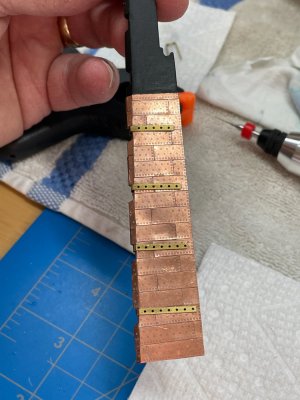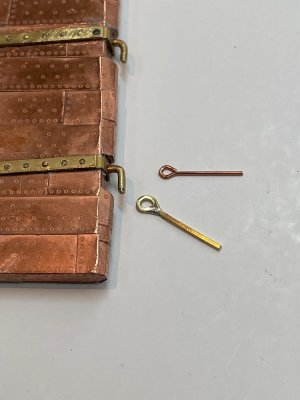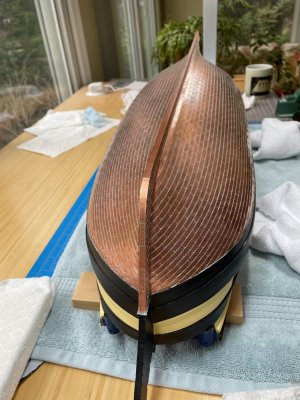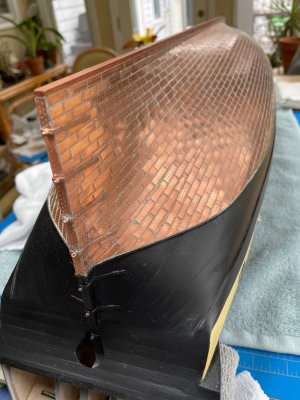Incredible coppering work! The overlapping makes it so realistic and authentic. Such splendid workmanship! 


 |
As a way to introduce our brass coins to the community, we will raffle off a free coin during the month of August. Follow link ABOVE for instructions for entering. |
 |

We use Renaissance Wax in our book restoration business and swear by it.Hi Michel,
Thank you for the compliment. After giving it much thought, I am leaning towards using Renaissance Wax. The recommendation in Bob Hunt's practicum was to apply several coats of Minwax Wipe-on Poly. Oil based polyurethane will turn yellow and darken over time. I'm not sure how well the water base poly works. I'm really not sure what I should be using. This is where I would very much appreciate advice from SOS members. Renaissance Wax is a brand of microcrystalline wax polish used for the protection of various materials and was developed in the early 1950s by the British Museum in collaboration with the National Gallery in London. It's used by conservators, museum professionals, antique collectors and artisans, It imparts a soft sheen after polishing. I am tempted to try out this product and see how well it holds up to prevent tarnishing. If it does not hold up, it can be removed with white spirits.
Again, any thoughts from fellow SOS members would be much appreciated.
Congratulations Andre on completing this substantial part of the build which will be the subject of considerable scrutiny by observers of your finished build.It’s been slow progress applying copper plates to the hull and I’m almost done. Not for any lack of interest, however, it seems I can only manage a few hours a day to the build. It occurred to me early that I might run out of plates because I am overlapping each plate. By the time I came to that realization I was committed to keep going. The photo below shows where I ran out of plates. The kit came with 1295 plates for each side. I was able to purchase an additional sheet of plates, 7x37 or 259 plates for each side.
View attachment 440885
The following photos show the hull plating completed and polished. I used both Flitz and Brasso metal polish.
View attachment 440886
View attachment 440887
View attachment 440888
View attachment 440889
View attachment 440890
View attachment 440891
View attachment 440892
View attachment 440893
Hi Mike,Very impressive. Shouldn't the top row of plates run parallel to the waterline?
Mike
I LOVE learning these sorts of details..Hi Mike,
I also wondered before starting the copper plating, whether the top rows of plates run parallel to the waterline. There is a very good article in Chapter 13 of Ship Modeler’s Shop Notes II, a publication of the Nautical Research Guild, Inc., that examines the topic of how copper plates terminated at the waterline. My interpretation is that 18th century ship’s copper plates curved upward toward fore and aft sections of the ship and intersected the waterline at an angle. The top edge of the copper plating was covered by a wooden batten. The use of copper belts parallel to the waterline came into use in the 19th century. There are photographs of an early model of the HMS Bellona in Anatomy of the Ship series showing copper plates intersecting the waterline at an angle. The model was used to demonstrate the practice of copper sheathing to King George III in 1778. Additionally, this kit of the HMS Vanguard was designed Chris Watton of Victory Models. He is known for attention to detail and historical accuracy. His plans and drawings show the copper plating intersecting the waterline at an angle giving the plating a “bowed” appearance.
I have my eye on this kit so I will follow along with great interest!First Build: Amati HMS Vanguard 1787, 1:72 scale. I appreciate the opportunity to share my first build with the SOS community. I have very limited experience with wood ship modeling and hope to receive valuable advice from members. So, all tips and comments are welcome. A little background about myself: I am a retired engineer, age 74, and now find that I have some time to to spend on a build. I started building the Billing Boats Cutty Sark model 50 years ago, but never finished and gave that kit away. Also, about the same time I purchased the Mantua Sergal HMS Victory, which I still have and have not started. The HMS Victory looks a bit daunting with plans in Italian and limited instructions in English. I became interested in building a model of the BlueJacket version of the USS Constitution since I live 30 miles south of Boston and I can visit the ship often. While researching wood ship modeling on the internet I found Robert Hunt’s Practicums on building various wood model kits. I contacted Bob to ask his opinion about this kit. He mentioned that the BlueJacket version is the 1812 configuration and the actual ship as configured today may not be helpful. The BlueJacket kit is also at a smaller scale than the Vanguard which makes the build a little more difficult. Bob suggested that if I really wanted to build a large complex kit to build the Amati HMS Vanguard and to purchase his practicum on building the kit. I did purchase his practicum and realize that it will be of considerable value to my effort. He explains all steps in great detail with techniques and tools to use. I believe his website, www.lauckstreetshipyard.com, is a valuable resource for novice ship modelers. I will be following the kit’s instructions as well as Bob Hunt’s practicum. So, now on with the build…View attachment 207709View attachment 207710







Welcome back Andre . I am a fan of your work. The detail you accomplish and the natural look and feel make for a fine model . Cheers GrantIn these photos I am adding a false keel. The false keel on 18th century British Naval ships was approximately 6” thick. At 1/72 scale that is .083”. This is not part of the kit’s instructions. However, since this feature existed on real ships, I decided to include it. The false keel was added to protect the main keel from damage due accidental groundings It was attached to the main keel with staples and could easily be replaced if needed. My false keel is made from 0.081” thick Swiss Pear wood.
View attachment 514170
View attachment 514171
View attachment 514172
